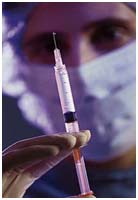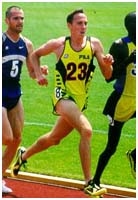This is intended to be a bare-bones review of physiology of muscle function. The concepts here have direct application to understanding how specific training improves (or decreases) endurance performance capacity. Basic Architecture
A single muscle fiber is a cyclindrical, elongated cell. Muscle cells can be extremely short, or long. The sartorious muscle contains single fibers that are at least 30 cm long. Each fiber is surrounded by a thin layer of connective tissue called endomysium. Organizationally, thousands of muscle fibers are wrapped by a thin layer of connective tissue called the perimysium to form a muscle bundle. Groups of muscle bundles that join into a tendon at each end are called muscle groups, or simply muscles. The biceps muscle is an example. The entire muscle is surrounded by a protective sheath called the epimysium. Between and within the muscle cells is a complex latticework of connective tissue, resembling struts and crossbeams that help to maintain the integrity of the muscle during contraction and strain. It is an amazing cellular system even before it contracts!
Interior Components
Every muscle cell contains a series of common components that are directly associated with contraction in some way, and influenced by training. I will briefly describe these. For now we will not worry about the rest (like the nucleus, ribosomes etc.).
The Cell Membrane – Controls what enters and leaves the cell. Contains regulatory proteins that are influenced by hormones like epinephrine (adrenalin) and insulin. The blood concentration of these hormones greatly influences fuel utilization by the muscle cell.
Contractile Proteins – Consist of actin and myosin plus some regulatory subunits. This is the part of each muscle cell that actually produces force. All of the rest of the machinery plays a supporting or repair function.
The Cytosol. The fluid medium of the cell. Provides a medium for diffusion of oxygen, ATP, etc. within the cell interior.
Mitochondria – The organelles in each muscle cell that contain oxidative enzymes and actually consume oxygen during exercise and convert the chemical energy contained in fat and carbohydrate to ATP that can be used by the cell to support contraction. Ultimately, via enzymatic processes occurring first in the cytosol and then the mitochondria, glucose and fat molecules (and certain amino acids) are broken down and combined with oxygen to form ATP, heat, carbon dioxide, and water. Each by-product has significance to the exercising athlete!
Capillaries – Not actually part of the muscle cell. The capillaries physically link the muscle and the cardiovascular system. Each muscle cell may have from 3 to 6 capillaries directly associated with it, depending on fiber type and training.
Read the next article : The Motor Unit on this subject































Trackbacks/Pingbacks